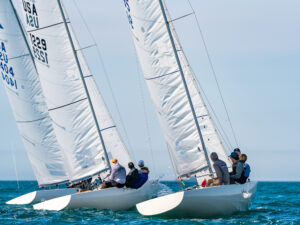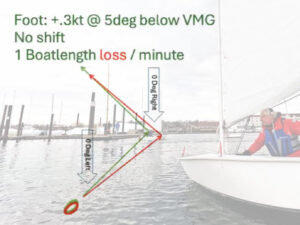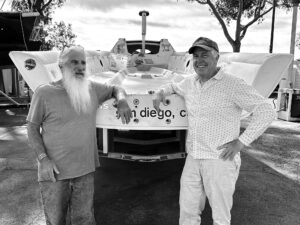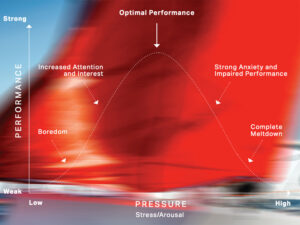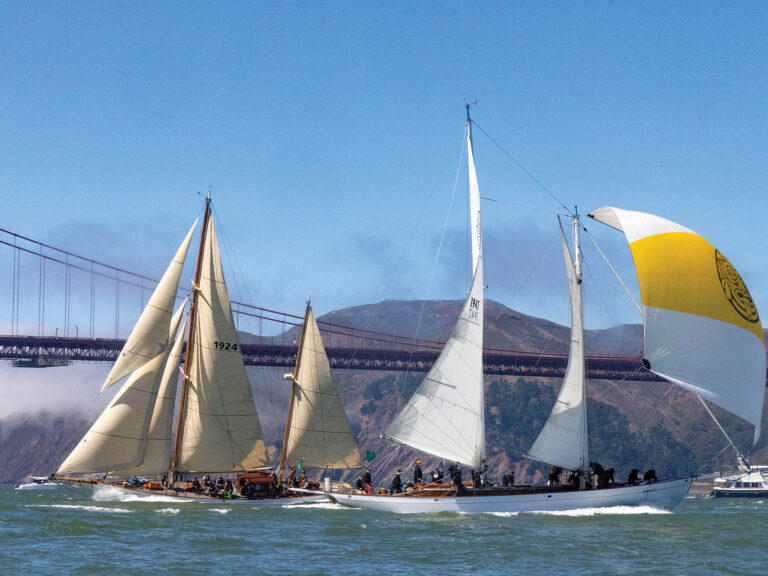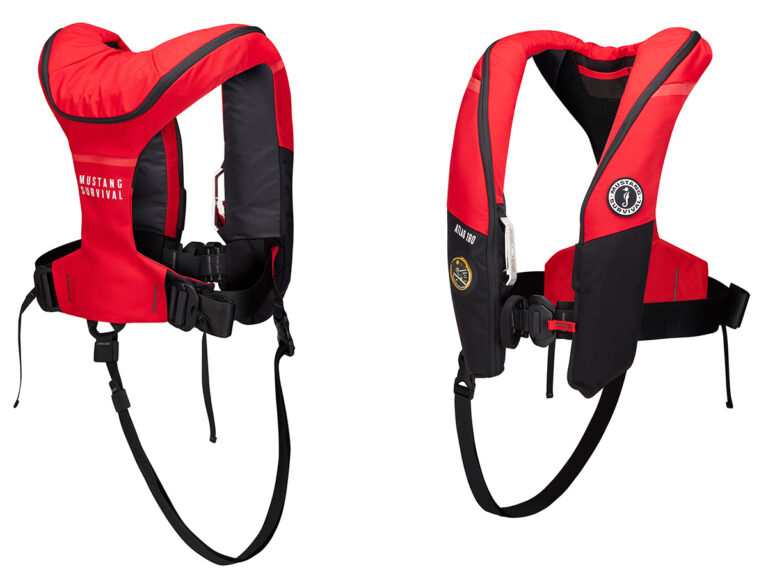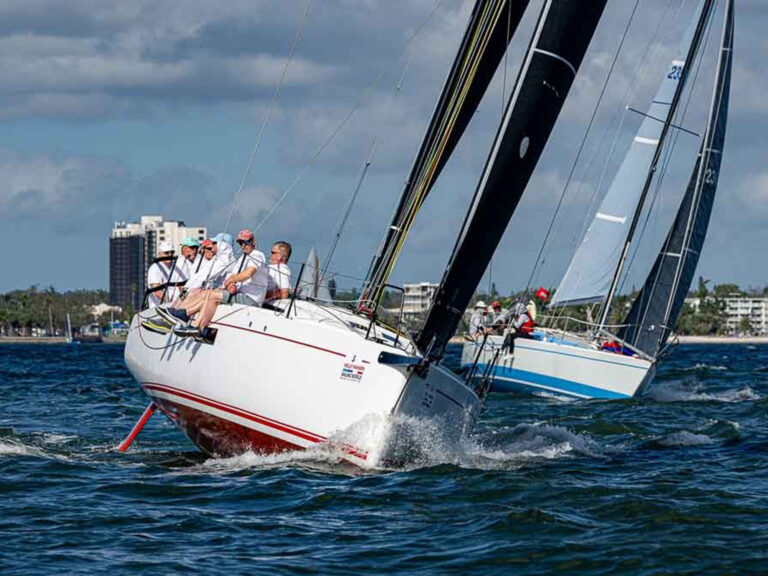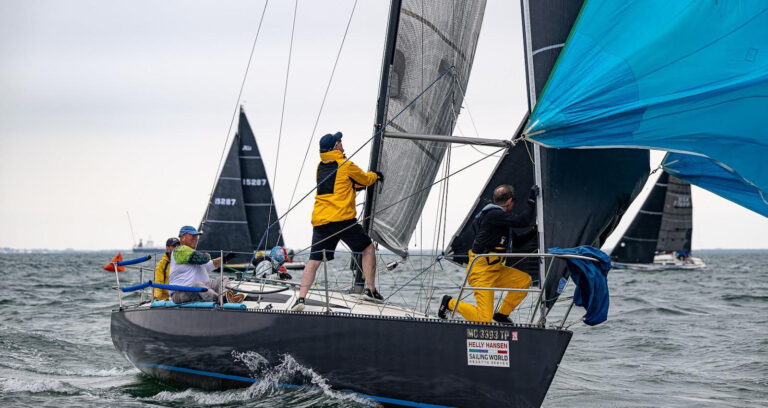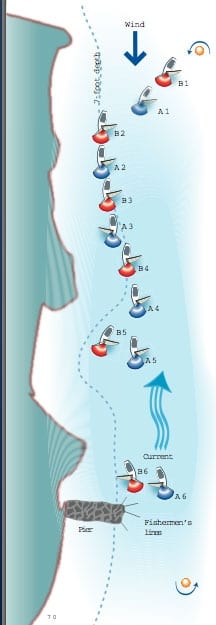
RulesMar06
We use Rule 18 several times in every race-usually at marks. However, the rule also applies “when boats are about to round or pass . . . an obstruction on the same side.” Obstructions come in a variety of sizes and shapes. Most of the time the rules that apply at an obstruction are identical to those that apply at a rounding mark. However, some obstructions are “continuing obstructions” and a special rule, Rule 18.5 (see below), applies while boats are passing such an obstruction.
Rule 18.5, Passing a Contunuing ObstructionWhile boats are passing a continuing obstruction, rules 18.2(b) and 18.2(c) do not apply. A boat clear astern that contains an inside overlap is entitled to room to pass betweeen the other boat and the obstruction only if at the moment the overlap begins there is room to do so. If there is not, she is not entitled to room and shall keep clear.
Several interesting questions from Bartz Schneider, who races an Express 37 on San Francisco Bay, involve a continuing obstruction and Rule 18.5. These provide me the opportunity to discuss why that rule exists, how it works, and how it differs from the rules that apply at an obstruction that is not a continuing obstruction.Before we delve deeper into Rule 18.5, we better figure out how a continuing obstruction differs from one that is not “continuing.” Because “continuing” is not in italics in the rules, we must consult a dictionary to determine its meaning. My dictionaries suggest that, in the context in which it is used in Rule 18.5, a continuing obstruction is an obstruction “marked by uninterrupted extension in space or time.” Therefore, for our purposes, a continuing obstruction is one that we can only pass by sailing an unusually long distance or by sailing for an unusually long period of time. Most obstructions, such as anchored boats, the end of a pier, or drifting chunks of debris, are not “continuing” so we can pass them by sailing just a boatlength or so in a very few seconds. The most obvious example of a continuing obstruction is a shore. In Bartz’ case, boats are running in moderate wind for a mile or more. To minimize the effect of a strong adverse current, they stay as close to the shore as possible. Obviously, the shore qualifies as a continuing obstruction.When racing on rivers or in areas with strong tidal currents, off wind legs are frequently sailed against adverse current. Boats battle for the inside position-to be as close to the shore as possible-because that position is much faster than sailing even a length or so further off the shore. Rule 18.5 is primarily intended to cover those situations.Let’s dissect Rule 18.5. It applies only “while boats are passing” a continuing obstruction. At non-continuing obstructions, boats reach the two-length zone before they begin to pass the obstruction. At the moment when one of two boats reaches the zone, they are either overlapped or not. If they overlap, Rule 18.2(b) applies, locking in the rights of the inside boat and the obligations of the outside boat. If there is no overlap, then Rule 18.2(c) locks in the rights of the boat clear ahead and the obligations of the boat clear astern. These rights and obligations remain locked in until both boats have passed the obstruction. When sailing along a shore, boats usually “are passing” the shore long before they come within two lengths of it. Because Rule 18.5 switches off Rules 18.2(b) and (c) while they are passing it, there is no locking in of rights and obligations as there normally is at a mark or obstruction, and the two-length zone plays no role.Take a look at the diagram to see this illustrated. At position 1, right after Annie and Bertie round the windward mark, they are already passing the shore. For these two Express 37s, which draw 7 feet, the outer edge of the obstruction is the 7-foot depth contour. The edge of the two-length zone “around” the obstruction would be a line 74 feet outside the 7-foot depth contour. The crews would have great difficulty determining where the zone begins, but, because Rules 18.2(b) and (c) do not apply, the location of the zone is irrelevant.So what rules do apply while boats pass a continuing obstruction? The answer is, “All the other rules.” Of those, the ones you need to keep in mind are Rules 10, 11, 12, 18.2(a), and 18.5. Let’s follow Annie and Bertie past the shore and apply these rules at each moment.At positions 1 and 2, Annie has right of way under Rule 12. At position 3, Annie jibes onto port tack. Bertie becomes the right-of-way boat under Rule 10 and begins to blanket Annie. There are three ways Annie can avoid breaking Rule 10-she can bear off and risk running aground; she can head up and give Bertie the favored inside position nearer the shore; or she can simply jibe back onto starboard and regain right of way under Rule 12. She chooses to jibe (position 4).Bertie watches his depth sounder like a hawk hoping the depth will increase so he can try to pass between Annie and the shore. Rule 18.5 tells him he will be entitled to room only if, at the moment an overlap begins, there is “room to pass between [Annie] and the [7-foot contour].” At position 5 the depth increases a bit and Bertie heads up slightly, blankets Annie, and overlaps her. This is the moment of truth. If Bertie were to run aground just after the overlap begins, that would make it clear that the required room had not been there when the overlap began. However, if he does not run aground after moving a couple of lengths along the shore, that would demonstrate that indeed there had been room for him to pass between Annie and the shore when the overlap began. Then, Bertie would be entitled to room under Rule 18.5 and, under Rule 18.2(a), Annie would be required to give it to him.At position 6 Annie and Bertie must luff to pass outside the end of a long pier. Bartz asked whether the pier is part of the continuing obstruction or a new separate obstruction. In my opinion, the answer depends on the length of the pier. If, as shown in the diagram, the pier’s outer end is near the 7-foot contour, then the pier is simply part of the continuing obstruction. If, however, the pier’s outer end was well outside the 7-foot contour so that boats had to sail in depths greater than their draft for several lengths in order to pass it, then the pier would be a separate obstruction and, because the boats would pass its outboard end quite quickly, it would not be a continuing obstruction.Bartz reported that fisherman had cast lines out from the pier, and he asked, “What is the status of those lines?” Because they extend out from the pier and boats cannot pass between the pier and the lines, I think that they should be considered part of the pier.As I write this column I am reminded of a particularly fun moment. Many years ago while team racing on the Trent River in England, I was overlapped inside running along a shore and had the distinct pleasure of calling for room to pass outside of a surprised cow that had waded into the river to drink.This column has been limited to discussion of passing a shore while sailing off wind. For a discussion of the rules that apply on a beat to windward along a shore, see the Rules columns in the September 2004 and November 2004 issues of Sailing World.E-mail for Dick Rose may be sent to rules@sailingworld.com.

